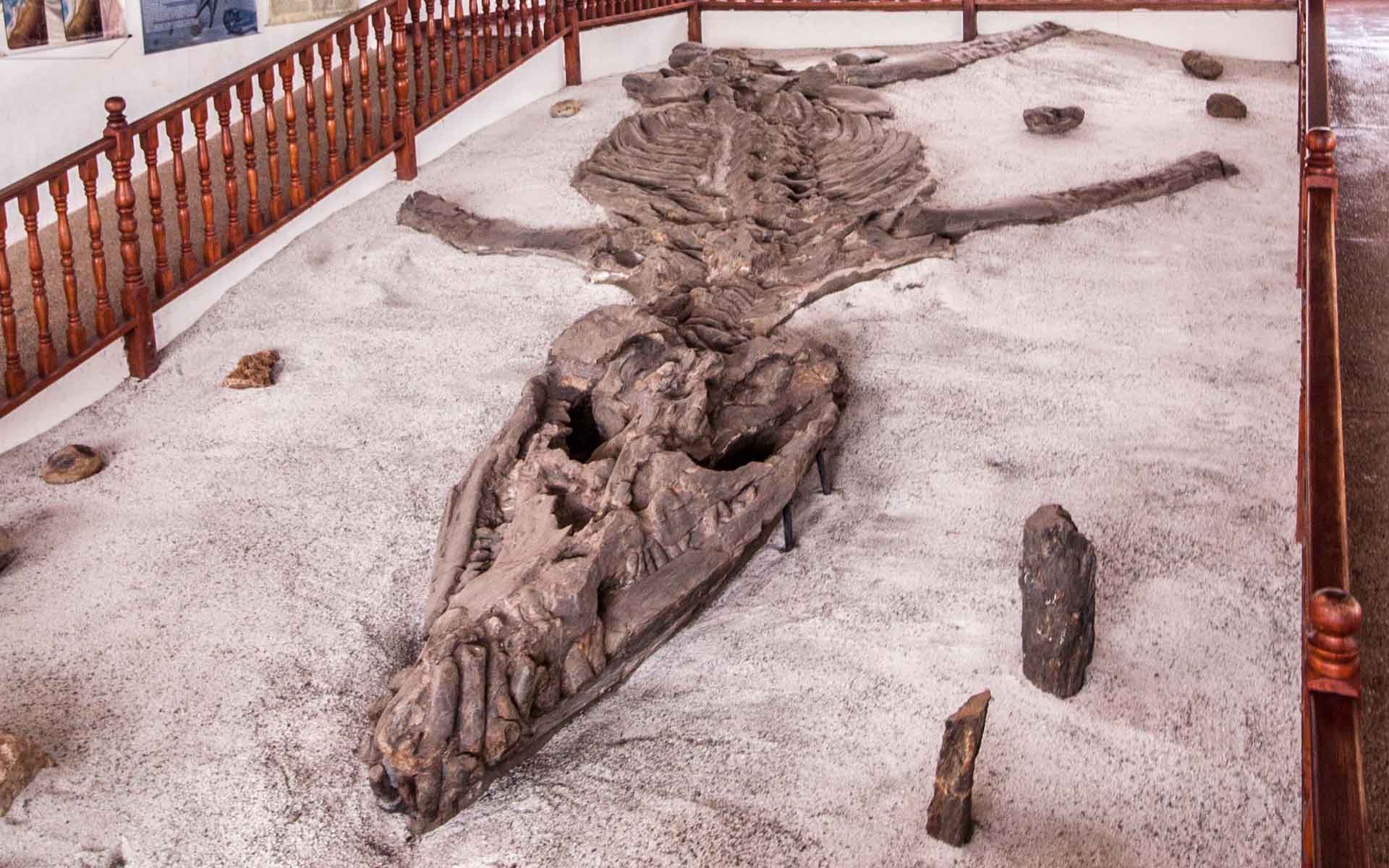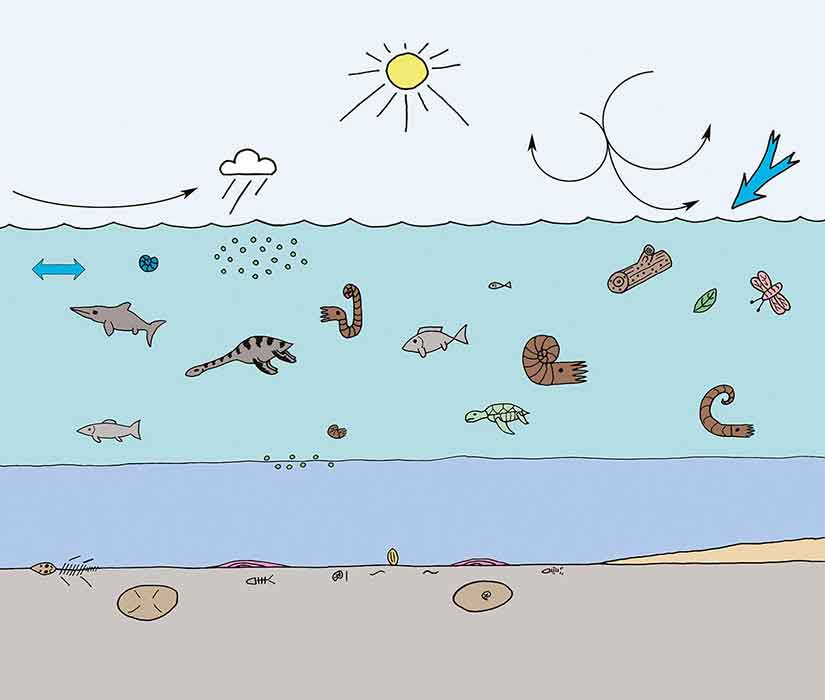Marine Reptile Lagerstätte from the Lower Cretaceous of the Ricaurte Alto
COLOMBIA

The exquisitely preserved “El Fósil” (Monquirasaurus boyacensis), an iconic seven-meter-long Early Cretaceous marine megapredator, with a 2.8-meter-long skull and 30 cm teeth, from Ricuarte Alto.
Geological Period
Lower Cretaceous
Main geological interest
Paleontology
Stratigraphy and sedimentology
Location
Ricaurte Alto Province, Boyacá, Colombia.
5°37’48.0″N, 73°33’00.0″W
The exquisitely preserved “El Fósil” (Monquirasaurus boyacensis), an iconic seven-meter-long Early Cretaceous marine megapredator, with a 2.8-meter-long skull and 30 cm teeth, from Ricuarte Alto.
The world’s most complete record of Lower Cretaceous marine reptiles and associated fauna.
The Ricaurte Alto preserves a unique marine fauna that opens an exceptional window into the marine reptile and associated fauna and flora of an equatorial Early Cretaceous epicontinental seaway, located between the northern and southern hemispheres and bordering the proto-Pacific Ocean and Tethyian realms. Exquisite preservation is characterized by very high levels of skeletal completeness and articulation of pliosaurs, plesiosaurs, ichthyosaurs, and marine turtles, which is critical for understanding the evolutionary history of these groups. The associated three-dimensionally preserved fish, exceptionally rich ammonite fauna, terrestrial plants, and dinosaur remains are also outstandingly important. The site also comprises a remarkably complete Hauterivian to lower Aptian sedimentary sequence, incorporating evidence for Cretaceous oceanic anoxic events (Noè and Gómez-Pérez, 2020).
- Geological description
The Paja Formation crops out almost continuously in the Alto Ricaurte region in the municipalities of Villa de Leyva, Sáchica and Sutamarchán. These deposits are mainly black shale with abundant calcareous concretions and the abundance of organic carbon. Deposition of the Paja Formation in the Alto Ricaurte took place during the Hauteriveran to Aptian in a world with high global sea levels, warm and equitable global temperatures. The “calcite seas” were dominated by marine reptiles, fish, and ammonites, which are now beautifully preserved. This preservation is strong evidence for rapid burial and other exceptional diagenetic conditions. The dysoxic–anoxic bottom waters precluded scavenging fish and cephalopods, severely reduced epibiont encrustation, and minimized the possibility of scavenging by air–breathing marine reptiles. The diversity of the marine reptile fauna is exemplified by the various groups such as pliosaurs, plesiosaurs, marine turtles, and ichthyosaurs. Marine reptiles of the Lower Cretaceous are scarce around the world, but in this area are abundant, with at least 12 species and genera, many undescribed (Noè and GómezPérez, 2020).
- Scientific research and tradition
The Ricaurte Alto has long been recognized as an exceptional fossiliferous deposit and has been studied by generations of national and international researchers and students. Commencing in the 1930s and 40s, the Ricaurte Alto strata were explored for their biostratigraphic importance and potential for hydrocarbon generation. During this time, the first marine reptiles (two articulated plesiosaurs, now Callawayasaurus colombiensis) were discovered and subsequently described (Welles, 1962). Commencing in the 1960s, considerable research effort has been undertaken on the strata, invertebrate (ammonite) fauna (Etayo-Serna, 1968), and flora of the Ricaurte Alto. Since the 1980s, an increasing number of exceptionally preserved marine reptiles have been described (Cadena and Parham, 2015; Cortes et al., 2021; Gomez-Perez and Noè, 2017). The site is now recognized as both a Lagerstätte and as globally important ‘Lower Cretaceous Gap’ deposits (Noè and Gómez-Pérez, 2020). Many marine reptiles and other taxa are awaiting formal description.
- Reference
Cadena, E. and Parham, J. (2015) ‘Oldest known marine turtle? A new protostegid from the Lower Cretaceous of Colomb’, PaleoBios, 32(1), pp. 2–42.
Cortés, D., Maxwell, E.E. and Larsson, H.C.E. (2021) ‘Re-appearance of hypercarnivore ichthyosaurs in the Cretaceous with differentiated dentition: revision of “Platypterygius” sachicarum (Reptilia: Ichthyosauria, Ophthalmosauridae) from Colombia’, Journal of Systematic Palaeontology, 19(14), pp. 969–1002. Available at: https://doi.org/10.1080/14772019.2021.1989507.
Gómez-Pérez, M. and Noè, L.F. (2017) ‘Cranial anatomy of a new pliosaurid Acostasaurus pavachoquensis from the Lower Cretaceous of Colombia, South America’, Palaeontographica Abteilung A, pp. 5–42. Available at: https://doi.org/10.1127/pala/2017/0068.
Noè, L.F. and Gómez-Pérez, M. (2020) ‘Plesiosaurs, palaeoenvironments, and the Paja Formation Lagerstätte of central Colombia: An overview.’, in The Geology of Colombia. Gomez, J., Pinilla Pachon, A.O. (Eds.). Bogotá: Servicio Geológico Colombiano, Publicaciones Geológicas Especiales (Mesozoic, 36), p. 43. Available at: http://doi.org/10.32685/pub.esp.36.2019.13.
Serna, F.E. (1968) ‘El Sistema Cretáceo en la región de Villa de Leiva y zonas próximas’, Geología colombiana, 5(1), pp. 5–74.
Welles, S.P. (1962) Elasmosaurid plesiosaurs with description of new material from California and Colorado. Los Angeles: University of California Press (University of California, Berkeley. Memoirs, 13).
- Author(s)
Marcela Gómez-Pérez
Servicio Geológico Colombiano
Leslie F. Noè
Universidad de los Andes
Manuel Gómez Guerrero
Servicio Geológico Colombiano
Marianela Vargas Anaya
Servicio Geológico Colombiano
Edwin Cadena
Universidad del Rosario

